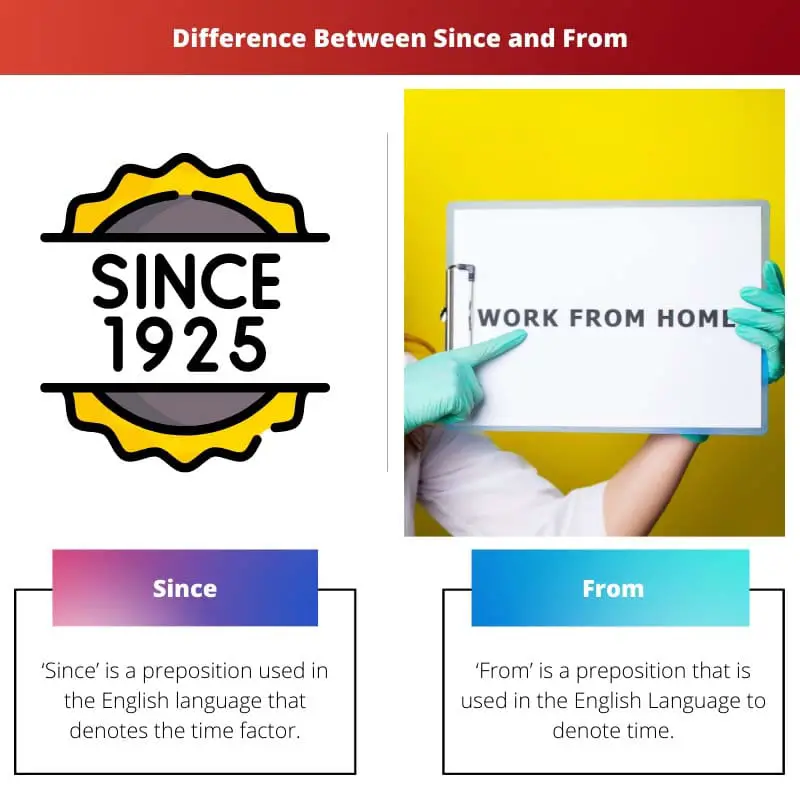“Since” refers to a specific point in time or starting period, indicating the beginning of a duration or a causal relationship. For example, “She has been studying since morning” implies the start of her studying coincided with the morning. “From” denotes the starting point of an action, event, or period, suggesting a continuous or ongoing process. For instance, “He works from 9 to 5” specifies the timeframe within which his work occurs, implying a consistent schedule.
Key Takeaways
- “Since” indicates a specific point in time or event that marks the beginning of a period. “Form” is used to indicate the starting point of a duration of time or a location.
- “Since” is used with a specific date or time. “Form” is used with a period or a starting location.
- “Since” and “form” indicate time or location; they have different meanings and uses.
Since vs From
The term ‘since’ can be used to define the beginning of any time period. For example, she has been cooking since morning. This shows that she started the cooking in the morning. The term ‘from’ can be used to define the starting period of time. This term can also be used to specify location. It can also be used to connect two parts of a sentence.

These two words have their prominence in different contexts. Both comments can be used to mention the time factor in a sentence.
For E.g.
- John has lived here since 2008.
- John has lived here from 2008 till 2019.
On analyzing the sentences mentioned above, the aspects noticed are
- Both sentences say that John has lived in that place since 2008.
- The second sentence gives complete information about John’s whereabouts.
- The first sentence does not give complete information.
Comparison Table
| Feature | Since | From |
|---|---|---|
| Function | Marks the starting point of a duration that continues to the present | Marks the starting point of an event, action, or period |
| Tense | Used with present perfect and past perfect tenses | Used with all tenses (present, past, future) |
| Focus | Emphasizes the duration or continuing state | Emphasizes the starting point or origin |
| Examples | * I haven’t seen John since Monday. (duration) * They have lived in France since 2010. (continuing state) | * The meeting will start from 9 am. * The train departs from London. * She has been working here from the very beginning. |
When to Use Since?
1. Indicating a Point of Time:
- Usage: “Since” is used to pinpoint a specific point in time from which a situation, action, or state started.
- Example: “She has been working at the company since 2010.” Here, “since” marks the starting point of her employment, which is the year 2010.
2. Expressing Causality or Reason:
- Usage: “Since” is employed to denote a causal relationship between two events or states, indicating that the latter is a consequence of the former.
- Example: “He has been feeling unwell since he ate that seafood.” In this sentence, “since” indicates that the feeling of unwellness is a result of consuming seafood.
3. Referencing Duration:
- Usage: “Since” can also refer to the duration that has passed since a particular event or starting point.
- Example: “They have been friends since childhood.” Here, “since” implies that the friendship started during childhood and has continued over a prolonged period.
4. Describing Continuity or Persistence:
- Usage: “Since” is utilized to emphasize the continuous or persistent nature of a situation or action from a specific point in time.
- Example: “The problem has persisted since the last software update.” This usage of “since” underscores that the problem began after the software update and has persisted thereafter.

When to Use From?
1. Denoting Starting Point:
- Usage: “From” is used to indicate the starting point of a period, action, or event.
- Example: “She works from Monday to Friday.” Here, “from” specifies the beginning of her work week, which is Monday.
2. Establishing Duration or Range:
- Usage: “From” is employed to establish a duration or range within which something occurs or exists.
- Example: “The store is open from 9 a.m. to 6 p.m.” In this sentence, “from” sets the timeframe during which the store remains open, starting at 9 a.m. and ending at 6 p.m.
3. Describing Origin or Source:
- Usage: “From” is used to indicate the origin or source of something.
- Example: “I received a gift from my friend.” Here, “from” specifies the giver of the gift, indicating that the friend is the source or origin of the gift.
4. Expressing Movement or Transition:
- Usage: “From” can also express movement or transition away from a particular point or state.
- Example: “He moved from his hometown to the city for better opportunities.” In this example, “from” indicates the departure point (hometown) and the direction of movement towards a new location (the city).

Main Differences Between Since and From
- Starting Point:
- “Since” indicates the initiation of an event or state at a specific point in time.
- “From” specifies the beginning of a period, action, or event.
- Duration or Range:
- “Since” can refer to the duration that has passed since a particular starting point.
- “From” establishes a timeframe or range within which something occurs or exists.
- Causality or Reason:
- “Since” expresses a causal relationship between events, indicating that one event is a consequence of another.
- “From” does not imply causality but rather emphasizes the starting point of an action or state.
- Continuity or Persistence:
- “Since” emphasizes the continuous or persistent nature of a situation or action from a specific point in time.
- “From” does not inherently emphasize continuity but rather establishes the starting point without emphasizing ongoing duration.




